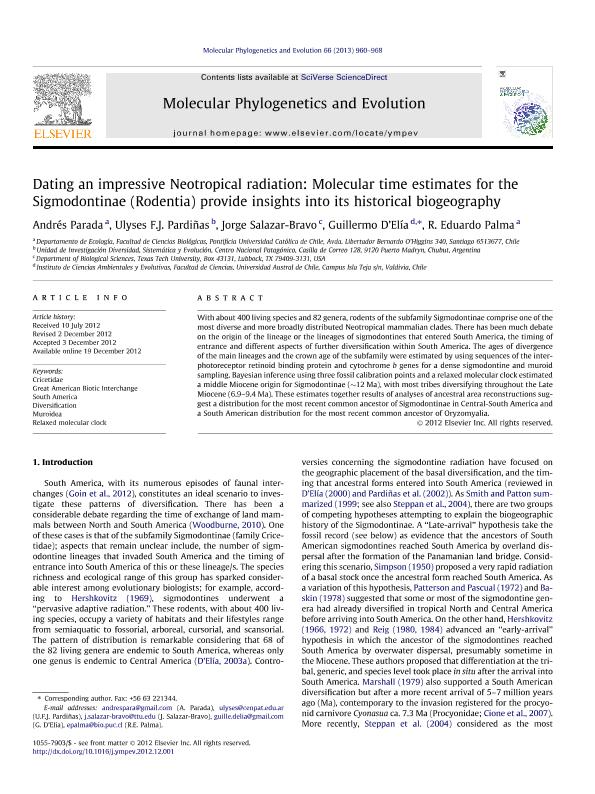Artículo
Dating an impressive Neotropical radiation: Molecular time estimates for the Sigmodontinae (Rodentia) provide insights into its historical biogeography
Parada, Andrés; Pardiñas, Ulyses Francisco J. ; Salazar Bravo, Jorge; D'elía, Guillermo; Palma, R. Eduardo
; Salazar Bravo, Jorge; D'elía, Guillermo; Palma, R. Eduardo
 ; Salazar Bravo, Jorge; D'elía, Guillermo; Palma, R. Eduardo
; Salazar Bravo, Jorge; D'elía, Guillermo; Palma, R. Eduardo
Fecha de publicación:
01/2013
Editorial:
Elsevier
Revista:
Molecular Phylogenetics and Evolution
ISSN:
1055-7903
Idioma:
Inglés
Tipo de recurso:
Artículo publicado
Clasificación temática:
Resumen
With about 400 living species and 82 genera, rodents of the subfamily Sigmodontinae comprise one of the most diverse and more broadly distributed Neotropical mammalian clades. There has been much debate on the origin of the lineage or the lineages of sigmodontines that entered South America, the timing of entrance and different aspects of further diversification within South America. The ages of divergence of the main lineages and the crown age of the subfamily were estimated by using sequences of the interphotoreceptor retinoid binding protein and cytochrome b genes for a dense sigmodontine and muroid sampling. Bayesian inference using three fossil calibration points and a relaxed molecular clock estimated a middle Miocene origin for Sigmodontinae (∼12 Ma), with most tribes diversifying throughout the Late Miocene (6.9–9.4 Ma). These estimates together results of analyses of ancestral area reconstructions suggest a distribution for the most recent common ancestor of Sigmodontinae in Central-South America and a South American distribution for the most recent common ancestor of Oryzomyalia.
Archivos asociados
Licencia
Identificadores
Colecciones
Articulos(CCT-CENPAT)
Articulos de CTRO.CIENTIFICO TECNOL.CONICET - CENPAT
Articulos de CTRO.CIENTIFICO TECNOL.CONICET - CENPAT
Citación
Parada, Andrés; Pardiñas, Ulyses Francisco J.; Salazar Bravo, Jorge; D'elía, Guillermo; Palma, R. Eduardo; Dating an impressive Neotropical radiation: Molecular time estimates for the Sigmodontinae (Rodentia) provide insights into its historical biogeography; Elsevier; Molecular Phylogenetics and Evolution; 66; 3; 1-2013; 960-968
Compartir
Altmétricas



